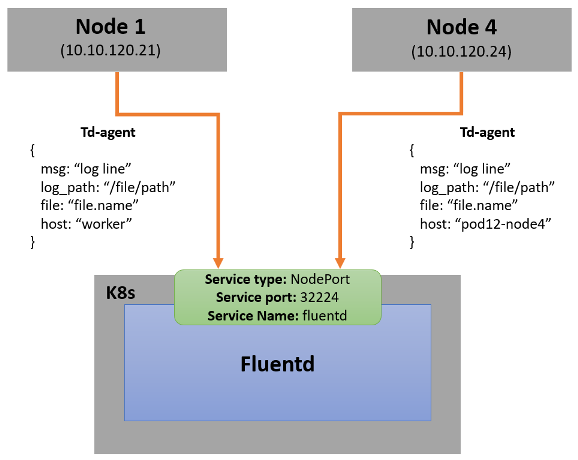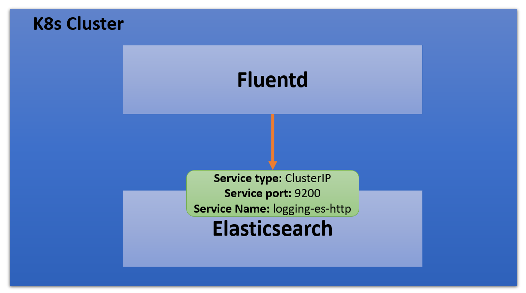5.3. Logs User Guide¶
5.3.1. Prerequisites¶
Require 3 VMs to setup K8s
$ sudo yum install ansible$ pip install openshift pyyaml kubernetes(required for ansible K8s module)- Update IPs in all these files (if changed)
Path Description ansible-server/group_vars/all.ymlIP of K8s apiserver and VM hostname ansible-server/hostsIP of VMs to install ansible-server/roles/logging/files/persistentVolume.yamlIP of NFS-Server ansible-server/roles/logging/files/elastalert/ealert-rule-cm.yamlIP of alert-receiver
5.3.2. Architecture¶

5.3.3. Installation - Clientside¶
5.3.3.1. Nodes¶
- Node1 = 10.10.120.21
- Node4 = 10.10.120.24
5.3.3.2. How installation is done?¶
- TD-agent installation
$ curl -L https://toolbelt.treasuredata.com/sh/install-redhat-td-agent3.sh | sh
- Copy the TD-agent config file in Node1
$ cp tdagent-client-config/node1.conf /etc/td-agent/td-agent.conf
- Copy the TD-agent config file in Node4
$ cp tdagent-client-config/node4.conf /etc/td-agent/td-agent.conf
- Restart the service
$ sudo service td-agent restart
5.3.4. Installation - Serverside¶
5.3.4.1. Nodes¶
- Inside Jumphost - POD12
- VM1 = 10.10.120.211
- VM2 = 10.10.120.203
- VM3 = 10.10.120.204
5.3.4.2. How installation is done?¶
- Using Ansible:
- K8s
- Elasticsearch: 1 Master & 1 Data node at each VM
- Kibana: 1 Replicas
- Nginx: 2 Replicas
- Fluentd: 2 Replicas
- Elastalert: 1 Replica (get duplicate alert, if increase replica)
- NFS Server: at each VM to store elasticsearch data at following path
/srv/nfs/master/srv/nfs/data
5.3.4.3. How to setup?¶
- To setup K8s cluster and EFK: Run the ansible-playbook
ansible/playbooks/setup.yaml - To clean everything: Run the ansible-playbook
ansible/playbooks/clean.yaml
5.3.4.4. Do we have HA?¶
Yes
5.3.5. Configuration¶
5.3.5.1. K8s¶
5.3.5.1.1. Path of all yamls (Serverside)¶
ansible-server/roles/logging/files/
5.3.5.1.2. K8s namespace¶
logging
5.3.5.1.3. K8s Service details¶
$ kubectl get svc -n logging
5.3.5.2. Elasticsearch Configuration¶
5.3.5.2.1. Elasticsearch Setup Structure¶

5.3.5.2.2. Elasticsearch service details¶
logging-es-http9200ClusterIP5.3.5.2.3. How to get elasticsearch default username & password?¶
- User1 (custom user):
- Username:
elasticsearchPassword:password123
- User2 (by default created by Elastic Operator):
- Username:
elasticTo get default password:$ PASSWORD=$(kubectl get secret -n logging logging-es-elastic-user -o go-template='{{.data.elastic | base64decode}}')$ echo $PASSWORD
5.3.5.2.4. How to increase replica of any index?¶
5.3.5.2.5. Index Life¶
30 Days
5.3.5.3. Kibana Configuration¶
5.3.5.3.1. Kibana Service details¶
logging-kb-http5601ClusterIP5.3.5.4. Nginx Configuration¶
5.3.5.4.1. IP¶
The IP address with https. Ex: “10.10.120.211:32000”
5.3.5.4.2. Nginx Setup Structure¶

5.3.5.4.3. Ngnix Service details¶
nginx32000NodePort5.3.5.4.4. Why NGINX is used?¶
5.3.5.4.5. Nginx Configuration¶
Path: ansible-server/roles/logging/files/nginx/nginx-conf-cm.yaml
5.3.5.5. Fluentd Configuration - Clientside (Td-agent)¶
5.3.5.5.1. Fluentd Setup Structure¶

5.3.5.5.2. Log collection paths¶
/tmp/result*/*.log/tmp/result*/*.dat/tmp/result*/*.csv/tmp/result*/stc-liveresults.dat.*/var/log/userspace*.log/var/log/sriovdp/*.log.*/var/log/pods/**/*.log
5.3.5.5.3. Logs sent to¶
Another fluentd instance of K8s cluster (K8s Master: 10.10.120.211) at Jumphost.
5.3.5.5.4. Td-agent logs¶
Path of td-agent logs: /var/log/td-agent/td-agent.log
5.3.5.5.5. Td-agent configuration¶
/etc/td-agent/td-agent.conf$ sudo service td-agent restart5.3.5.5.6. Config Description¶
Get the logs from collection path
- Convert to this format{msg: “log line”log_path: “/file/path”file: “file.name”host: “pod12-node4”}
Sends it to fluentd
5.3.5.6. Fluentd Configuration - Serverside¶
5.3.5.6.1. Fluentd Setup Structure¶

5.3.5.6.2. Fluentd Service details¶
fluentd32224NodePort5.3.5.6.3. Logs sent to¶
Elasticsearch service (Example: logging-es-http at port 9200)
5.3.5.6.4. Config Description¶
- Step 1
- Get the logs from Node1 & Node4
- Step 2
log_path add tag (for routing) /tmp/result.*/.*errors.daterrordat.log /tmp/result.*/.*counts.datcountdat.log /tmp/result.*/stc-liveresults.dat.txstcdattx.log /tmp/result.*/stc-liveresults.dat.rxstcdatrx.log /tmp/result.*/.*Statistics.csvixia.log /tmp/result.*/vsperf-overall*vsperf.log /tmp/result.*/vswitchd*vswitchd.log /var/log/userspace*userspace.log /var/log/sriovdp*sriovdp.log /var/log/pods*pods.log
- Step 3
- Then parse each type using tags.
- error.conf: to find any error
- time-series.conf: to parse time series data
- time-analysis.conf: to calculate time analyasis
- Step 4
host add tag (for routing) pod12-node4node4 workernode1
- Step 5
Tag elasticsearch node4index “node4*” node1index “node1*”
5.3.6. Elastalert¶
5.3.6.1. Send alert if¶
- Blacklist
- “Failed to run test”
- “Failed to execute in ‘30’ seconds”
- “(‘Result’, ‘Failed’)”
- “could not open socket: connection refused”
- “Input/output error”
- “dpdk|ERR|EAL: Error - exiting with code: 1”
- “Failed to execute in ‘30’ seconds”
- “dpdk|ERR|EAL: Driver cannot attach the device”
- “dpdk|EMER|Cannot create lock on”
- “dpdk|ERR|VHOST_CONFIG: * device not found”
- Time
- vswitch_duration > 3 sec
5.3.6.2. How to configure alert?¶
- Add your rule in
ansible/roles/logging/files/elastalert/ealert-rule-cm.yaml(Elastalert Rule Config) - name: anythingtype: <check-above-link> #The RuleType to useindex: node4* #index namerealert:minutes: 0 #to get alert for all cases after each intervalalert: post #To send alert as HTTP POSThttp_post_url: # Provide URL
- Add your rule in
Mount this file to elastalert pod in
ansible/roles/logging/files/elastalert/elastalert.yaml.
5.3.6.3. Alert Format¶
{“type”: “pattern-match”, “label”: “failed”, “index”: “node4-20200815”, “log”: “error-log-line”, “log-path”: “/tmp/result/file.log”, “reson”: “error-message” }
5.3.7. Data Management¶
5.3.7.1. Elasticsearch¶
5.3.7.1.1. Q&As¶
Where data is stored now? Data is stored in NFS server with 1 replica of each index (default). Path of data are following:
/srv/nfs/data (VM1)/srv/nfs/data (VM2)/srv/nfs/data (VM3)/srv/nfs/master (VM1)/srv/nfs/master (VM2)/srv/nfs/master (VM3)
If user wants to change from NFS to local storage, can he do it?
Yes, user can do this, need to configure persistent volume. (ansible-server/roles/logging/files/persistentVolume.yaml)
Do we have backup of data? Yes. 1 replica of each index
When K8s restart, the data is still accessible? Yes (If data is not deleted from /srv/nfs/data)
5.3.8. Troubleshooting¶
5.3.8.1. If no logs receiving in Elasticsearch¶
- Check IP & port of server-fluentd in client config.
- Check client-fluentd logs,
$ sudo tail -f /var/log/td-agent/td-agent.log - Check server-fluentd logs,
$ sudo kubectl logs -n logging <fluentd-pod-name>
5.3.8.2. If no notification received¶
- Search your “log” in Elasticsearch.
- Check config of elastalert
- Check IP of alert-receiver
